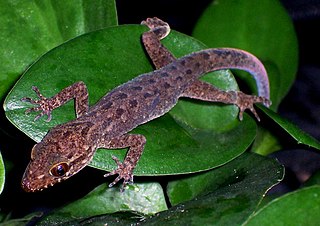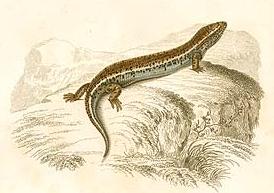
Hemiphyllodactylus is a genus of geckos ranging from India and China southward to Southeast Asia and Oceania. Species of Hemiphyllodactylus are commonly known as half leaf-fingered geckos. Many species are known as dwarf geckos or slender geckos.

Cnemaspis is a genus of diurnal (day) geckos found in Asia. With over 100 species, it is one of the most diverse genera of geckos. Molecular phylogenies suggest that the two regional groupings may form distinct clades which are not each other's closest relatives.

Cyrtodactylus is a diverse genus of Asian geckos, commonly known as bent-toed geckos, bow-fingered geckos, and forest geckos. The genus has 361 described species as of 2024, which makes it the largest of all gecko genera.

Pseudocalotes is a genus of lizards in the family Agamidae. The genus is endemic to Southeast Asia.

Chalcides is a genus of skinks.

Miriam's skink is a skink, a lizard in the family Scincidae. The species is endemic to Thailand.

Lipinia is a genus of skinks, lizards in the family Scincidae. Species in the genus Lipinia are commonly called lipinias.

Lygosoma is a genus of lizards, commonly known as supple skinks or writhing skinks, which are members of the family Scincidae. Lygosoma is the type genus of the subfamily Lygosominae. The common name, writhing skinks, refers to the way these stubby-legged animals move, snake-like but more slowly and more awkwardly.
Melanoseps is a genus of lizards, known commonly as limbless skinks, in the family Scincidae. The genus is endemic to Sub-Saharan Africa.

Ophiomorus is a genus of Old World skinks. The limbs are either reduced or absent, depending on the species. They are sometimes known as limbless skinks or snake skinks. Members of the genus live under rocks or in burrows.
Scolecoseps is a genus of skinks, lizards in the family Scincidae. The genus is endemic to East Africa.

The genus Sphenomorphus – vernacularly also known as the common skinks – currently serves as a "wastebin taxon" for numerous skinks. While most or all species presently placed here are probably rather close relatives, the genus as presently delimited is likely to be not monophyletic and is in need of review. Some species in this genus have been moved to Pinoyscincus.

Dibamus is a genus of legless lizards in the family Dibamidae.

Scincinae is a subfamily of lizards. The subfamily contains 33 genera, and the genera contain a combined total of 284 species, commonly called skinks. The systematics is at times controversial. The group is probably paraphyletic. It is one of three subfamilies of the family Scincidae, the other two being Acontinae and Lygosominae.

Dumeril's monitor is a species of lizard in the family Varanidae. The species is endemic to Southeast Asia.

Tytthoscincus is a genus of skinks. Originally defined to include a few species from the Philippines, the genus now includes many species from South-East Asia in general.
Lygosoma angeli, also known commonly as Angel's writhing skink, is a species of lizard in the family Scincidae. The species is native to Southeast Asia.
Herbert's supple skink, also known commonly as Herbert's writhing skink is a species of lizard in the subfamily Lygosominae of the family Scincidae. The species is native to Malaysia and Thailand.

Larutia miodactyla, the single finger larut skink or Titiwanga larut skink, is a species of skink. It is endemic to Peninsular Malaysia.
Larutia seribuatensis, also known as the two-lined two-toed skink or Seribuat larut skink, is a species of skink. It is endemic to the Seribuat Archipelago (Malaysia) and occurs on Tioman Island as well as its small neighbor, Tulai Island.














